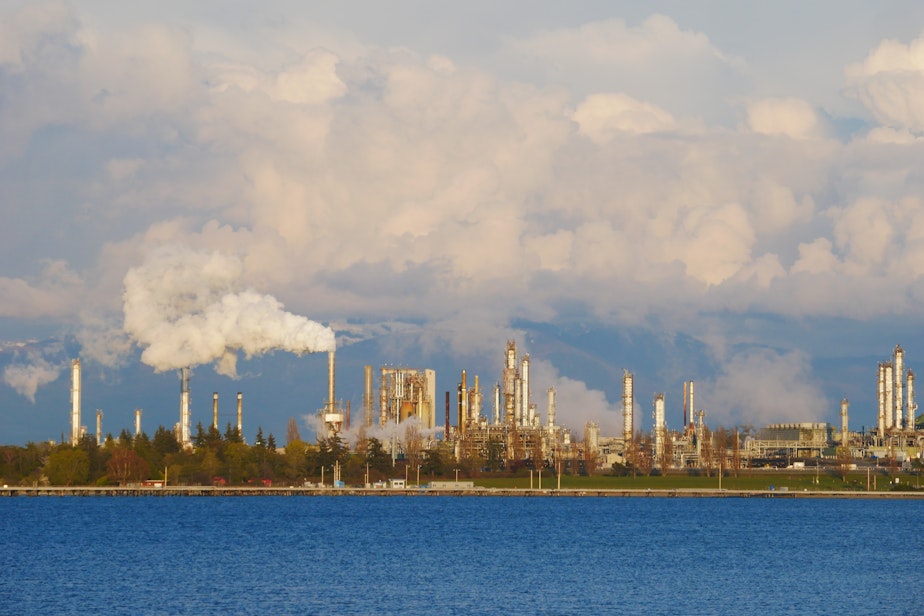Washington state starts capping climate pollution from its biggest sources

Washington state is going after big polluters as it tries to slash its planet-heating pollution.
A new cap on industrial emissions took effect on Jan. 1, a decade after Washington Gov. Jay Inslee started pushing for economy-wide reductions of climate-harming greenhouse gas emissions. The state is now gearing up for its first auction of pollution allowances, which will force some major polluters to pay for every ton of carbon dioxide they emit, on Feb. 28.
“This is something we legitimately can crow about,” Inslee said in January. “We do have the best suite of policies to build clean energy in our state in the United States.”
Over the past decade, Washington’s climate-damaging pollution has stubbornly increased despite state laws requiring emissions to fall below 1990 levels by the year 2020 and shrink 95% by 2050.
“Now we can show them real results, not just promises of action,” Inslee said.
The state’s new “cap-and-invest” law imposes an emissions cap on businesses that puff out at least 25,000 metric tons of heat-trapping pollution annually. To keep polluting, those businesses can buy a limited number of carbon allowances — basically, pollution permits — which go on virtual auction four times a year.
Sponsored
The auctions themselves are shrouded in secrecy. The state’s carbon-capping law prohibits businesses from disclosing their bids, or even whether they intend to participate in an auction, “to prevent bidder collusion and minimize the potential for market manipulation.”
Auction proceeds go to reduce pollution and help hard-hit communities prepare for disasters made worse by climate change, such as heat waves, fires, and floods.
The floor price for the February auction is set at $22.20 for a ton of carbon dioxide, enough to provide a massive influx of cash to the state’s climate and clean energy programs. Inslee’s office has estimated the quarterly auctions will raise $1.7 billion over the next two years.
In an email, Altinay Karasapan with the nonprofit Climate Solutions said the new revenue “will lead to drastic cuts in climate pollution, as well as cleaner air, cleaner homes, and more resilient communities in our state.”
Some big polluters, including fuel suppliers and the state’s two largest universities, need to make steep and immediate pollution reductions of 7% a year, or buy their way out of that mandate.
Sponsored
But many of the biggest climate culprits, like oil refineries, pulp mills, and other manufacturers, don’t have to cut pollution as soon or as fast as others due to fears they might take their businesses and jobs elsewhere.
Refineries and other “emissions-intensive, trade-exposed” manufacturers get to keep polluting at their current rates for the next four years. Then they face a 3% reduction from 2027 to 2031 and another 3% from 2031 to 2034.
While other industries have to pay for their pollution allowances, the energy-intensive sectors get theirs free.
Even with the special treatment, Jessica Spiegel with the Western States Petroleum Association said oil refineries are hard-pressed to cut pollution as fast as the state wants them to.
Sponsored
“How do we get there so fast? We need to be building new things right now,” Spiegel said.
She said cleaner equipment, such as boilers that run on electricity rather than oil, isn’t on the market yet.
The BP, HollyFrontier, and Marathon oil refineries on the shores of Puget Sound are, respectively, Washington’s second, third, and fifth-biggest sources of carbon pollution.
Eric Zimpfer, who manages the BP refinery, said the facility is producing more bio-diesel and making efficiency improvements to cut emissions faster than the state mandate.
In October 2021, BP announced $270 million in investments at its Cherry Point, Washington, refinery, aimed at cutting carbon emissions there 7% by the end of 2023.
Sponsored
“We're going to be a net-zero company across our operations,” Zimpfer said. “This is something the world needs to move to.”
BP has vowed to achieve net-zero emissions from its global operations by 2050 or sooner, though in February the British oil giant announced that its profits had doubled in 2022 and that it was scaling back its clean-energy ambitions. Now, BP aims to reduce its emissions 20% to 30% by the end of this decade, not the 35% to 40% promised earlier.
Twelve eastern states have capped carbon emissions from power plants. So far, only the West Coast states of California, Oregon, and Washington have started capping pollution from industry more broadly.




